The Sounding Beauty of Ideas
eContact! 21.2 — Dematerialization of the Sounding Object: Conceptual approaches to sound-based artistic practices (July 2023) http://econtact.ca/21_2/bernal_soundingbeauty.html
The original Spanish version of this text was published as “La belleza sonora de las ideas” in Sul Ponticello 60 (June 2016). In 2022–23 it was translated and revised by the author and shirling & neueweise for its publication in eContact! 21.2.
That we could find the sound of the wind rustling the leaves of a poplar, or a Chopin Nocturne, a Monteverdi madrigal or a late Morton Feldman work to be beautiful, tremendously beautiful, is beyond doubt, as it is for so many other musical works and texts on æsthetics.
That we could find a 4'33" by John Cage, a Chord Catalogue by Tom Johnson, a Poème symphonique for 100 metronomes by György Ligeti or the experience of hearing two marching bands playing as they cross paths (Charles Ives) to be interesting, tremendously interesting ideas, is also — subjective nuances aside — beyond all doubt.
Avec étonnement
The doubt (or suspicion) emerges clearly when we suggest that nothing more than an idea could be beautiful for us.
By “nothing more” we mean the idea by and of itself, in all its intangible splendour, entirely independent of any possible experimentation with it as material (be that sonorous, plastic, literary…). Not an idea as a strategy to create a concrete materiality, but “just” an idea, and nothing more.
By “beautiful” we mean beautiful as with a late Morton Feldman work, a Monteverdi madrigal, a Chopin Nocturne or as with the sound of the wind rustling the leaves of a poplar.
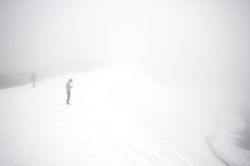
And, although this text, per se, could also be extended to comprise Beauty in the visual, sculptural or literary realms, I will attempt to restrict it as much as possible to that which I consider, with the expression “sounding beauty” [in Spanish: belleza sonora], relates directly to the æsthetic experience of sound (regardless of whether we mean music, sound art or any other definition that might seem appropriate).
And, although I am aware that within the field of Æsthetics the notion of “the beautiful” as a singular object of study has been amply called into question through the introduction of further categories (such as the sublime, the grotesque, the comic, the ugly…), I wish to take on the challenge of remaining within what we simply perceive — beyond all doubt — as beautiful, despite any qualms we may have concerning the complexity of its definition. Although it is by no means my intention (or role) to restrict the breadth of the æsthetic experience, I wish to avoid at all costs that the fate of these reflections be to conclude something like “that which is interesting can also be an æsthetic category.” For such a denouement would be the vulgar gyration of a smoke tunnel rather than the beautiful rustling sound of the wind.
Modestement
I would like to begin my approach by offering the counterexample of an extreme hypothetical case. Let’s suppose I attend a concert in which someone performs one of Chopin’s Nocturnes. As has already been noted, this experience will be perceived by me (or any other audience member, for that matter) as something that is undoubtedly beautiful, even if this particular Nocturne is not one of my favourites and even if the performance is not especially brilliant.
Suppose now that I attend another concert and that its programme includes the premiere of a new work written in an impeccable “Chopin style”. In all likelihood, this experience will be perceived by me as something that is, if I may use the expression, absolutely “anti-beautiful”. And it would remain so even in the case that the work is later discovered to have been written by Chopin himself (perhaps the composer had plagiarized the manuscript of a heretofore unknown Nocturne…).
Music alone is incapable of embodying that which it seeks to articulate.
The fact that two experiences having such similar material content could produce such a markedly different æsthetic experience should lead us to suspect that in this concrete æsthetic experience there is something beyond the merely material contributing, in a very conspicuous manner, to my ability to perceive the sounding beauty of the materiality of that which is sounding. For me, the “idea” of creating music in the style of Chopin well into the 21st century seems entirely anti-æsthetic, to such an extent that the potential beauty of its materiality is completely incapable of compensating for the anti-beauty of the underlying idea — something that doesn’t happen to me when I hear the music of Chopin, knowing full well that it was in fact composed in the Romantic period.
Of course, the fact that this hypothetical case could be perceived by me this way by no means implies that everyone should perceive it thus. It could well be that there are others who don’t feel that something like this is as terrible as I do, but it would also certainly not be difficult for them to imagine similar examples, cases in which the mediation of an idea — beyond its materiality — decisively determines their æsthetic experience.
Postulez en vous-même
Another preliminary example: the experience of live music. One of the reasons attending a live concert can result in a more gratifying experience of a musical work than hearing it on a recording is due, in large part, to a single factor: knowing that the performance of the work is being executed at exactly the same time as I witness it. We could also mention the influence of other material factors such as, on occasion, the direct sound emanating from the sound sources, the presence of the musicians in the same space as the listeners… However, while I don’t want to undermine the importance of these facts, we also encounter real cases where neither the presence of musicians nor direct sound is involved, but the live music is nevertheless of higher value than the equivalent recorded music. Consider, for example, a live radio broadcast. Or the curious adjacent hall of the Juan March Foundation in Madrid, where, when the main concert hall is at full capacity, it is still possible to attend the concert live — albeit in the form of a large-screen projection — and to gain undeniably more pleasure and delight than would be possible by downloading an archived podcast of the concert and viewing it in the comfort of your own home.
Continuing the thread, we arrive at the experience of free improvisation. There is no shortage of examples in which the materiality of what is produced does not differ significantly from the materiality of certain composed music or fixed media works of the last 30 years. Nevertheless, the very fact that everything is being created in the moment, that the development of materials is not predetermined and could “go” anywhere, can be a sufficiently beautiful idea as to guarantee us a more than gratifying æsthetic experience.
In these two situations we can contemplate how the beauty of materiality is contrasted with or enhanced by an immaterial element. However, this element never ceases to have a prescriptive value within the whole of the work or experience to which it belongs, acting more as a kind of gateway to the perception of the sounding matter’s beauty: it either blocks or facilitates our access, but once we have entered or turned away, this immateriality remains behind us, without very much to contribute to our æsthetic experience at any given moment.
Portez cela plus loin
But we have charged ourselves with the task of taking things further still. Beyond the situation within which the immateriality of sound is only a threshold that we can cross (or not). We have proposed to go there. Where the idea becomes the main creative statement par excellence, accompanied or not by a related materiality. And to try to reflect on those creative places and moments when, tying a knot with Plato, we could say that ideas participate in the sounding beauty.
And to assert The Sounding Beauty of Ideas…
Enfouissez le son
… In The Absent
To lose, to erase the matter as a creative statement: dematerialization.
As was the case for Georg Nussbaumer’s music theatre installation Ringlandschaft mit Bierstrom (2013). The Austrian composer’s project is entirely based on Wagner’s tetralogy, the Ring cycle, with 16 hours of music played over two days that only the performers can hear — through their headphones. What reaches the audience are no more than remnants of the original, barely recognizable. But what we actually hear, rather than these remnants, is the trace of the absent Wagner (Video 1). To hear the original requires physically engaging with the work: only by submerging one’s head inside a water barrel outfitted with a surface-mount speaker is it possible to hear the Wagner recording that the performers are listening to. It is sound that is aware of its own non-existence, the beauty of what-once-was.
The American composer and media artist Jessie Marino’s video work Ritual I :: Commitment :: BiiM (2011) consists principally of a snare drum being struck at a mechanically regular interval, momentarily made visible each time the sound triggers a flash of light (Video 2). At some point during the piece, something “new” happens for a very short time before the snare drum continues as before through to the end of the piece, but our listening experience has been radically changed. This “something” that happened is the sudden appearance of an excerpt of the song I’ll Make Love to You by Boyz II Men, which reveals the origin of the snare drum material: the performer in the video was simply playing the corresponding snare drum hits in the song, perfectly timed with the song’s own absolutely regular snare hits; virtually everything else of the piece has been erased. Marino’s work provides a fantastic example of how our perception can be altered from listening to the mere material to listening to the context, in this case of something that is no longer present, but remains only as a memory.
Du bout de la pensée
… In The Imaginary
In fact, the sound that is no longer sound would seem to behave like an idea that is able to transfigure the presence of sound into an absence, thus transporting the sound itself back to the world of imagination in which it was conceived. It is as if the sound traces a round-trip path from the imaginary to the sounding material and back again to the imaginary.
But it can happen that this round trip occurs as something completely imaginary. Like a dream of the sound while walking:
The sound of one foot tapping.
Ken Friedman — Zen Vaudeville (1966)
Is it necessary to “perform” this action for it to be perceived?
Or:
Song of Pleasure
I am rowing a boat on a lake.
The sounds — the regular
breathing, the small creaking
and thudding sounds of the
oars in the rowlocks, the
water lapping and sucking at
the belly of the boat, the
occasional passing Bird —
all combine to make a song
of pleasure.
Cornelius Cardew — “Song of Pleasure”, from Schooltime Compositions (1967)
In short, it is a question of engaging more with the act of listening than with sound itself, with the traces of sounds that have been heard but are no longer sound.
Seul, pendant un instant
… In Its Privacy
A work that is almost imaginary, Robin Hoffmann’s Œhr for Solo Listener (2006) does not, during its performance, actually produce any sound outwardly, but it does cultivate a specific approach to listening. The German composer details a series of actions in the score that are to be executed by the performer with their hands positioned directly in front of their ears, eliciting for the performer a rich listening experience forged by a constantly changing filter effect that is perceptible by their ears alone (Video 3, Fig. 2). It is, therefore, a work that can only be materialized in the privileged privacy of whoever performs the score, at the point where these multiple paths between the imaginary and the material sound converge and blur each other, or perhaps where they merge and form a unique, private path.
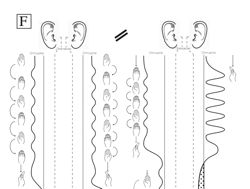
Such an individualized experience is also inherent to the performance of Tom Johnson’s Private Pieces (1976). In these text-based works, the American minimalist composer proposes a combination of reading and music (meant to be played, if possible) to the performer and would seem to relocate the usual collectivity of the musical experience to the intimacy and privacy of armchair reading.
Once upon a time there was a tiny blip. (Play a very soft high note.) He was so small and so soft that you could not even hear him unless you listened very carefully. (Play the high note again, very softly.) He was always kind and friendly to everyone. But in the same neighborhood there lived a big rumble who was just the opposite. (Play a low loud rumble with your left hand and continue playing it as you read.)
Tom Johnson — The Big Rumble and the Tiny Blip, from Private Pieces (1976)
In some of the American experimental composer Pauline Oliveros’ Sonic Meditations, notably number V, the privacy of the sonic experience shows itself reducing (or expanding?) the musical experience to merely listening to the environment, without our presence:
Take a walk at night. Walk so silently that the bottoms of your feet become ears.
Pauline Oliveros — Sonic Meditations: V. Native (1971)
Ne parlez pas
… In The Unspeakable
Should ideas be limited by their communicability, by a conceptuality that is understood as a mere verbalization of one’s æsthetic intention? Indeed, this is the direction suggested by the definition of conceptual art as pioneered by Henry Flynt, who declared that “concept art is a kind of art in which the material is language.” (Flynt 1963) But then what of Etude 1960 #7 (Fig. 3), composed — proposed? devised? — by La Monte Young the year before Flynt wrote his pivotal article? 1[1. Normally referenced according to its publication in An Anthology (Ed. La Monte Young, 1963), the article itself was written in 1961.]
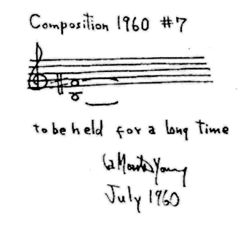
A perfect fifth; nothing more. Conceptually trivial; materially obvious. But what this journey from the imaginary to the sounding generates is indescribable, the experience expanding and developing itself from the obvious and trivial until it assumes the form of an unspeakable idea that only becomes possible through its paradox of not knowing whether it is an idea or matter.
Then there is kairos, by the German composer mathias spahlinger, which demonstrates the paradox of a verbally formulated idea whose æsthetic enhancement appears only as it transcends itself, evolving from text toward the incommunicable sounding matter.
a long duration… and in the right moment: stop; or interrupt and continue… repeatedly… and stop.
mathias spahlinger — “kairos”, from vorschläge: konzepte zur ver(über)flüssigung der funktion des komponisten (1993)
Or, to pursue the idea even further, again Pauline Oliveros:
What constitutes your musical universe?
Pauline Oliveros — Sonic Meditations: XXI (1971)
Ignorer sa propre présence
… In The Otherness
The other materiality. Art as a relation with an Other that is different from itself. In his Gehaltsästhetik: Eine Kunstphilosophie, Harry Lehmann positions the “æsthetics of content” as a turning point in the art scene of the nineties, instigating a challenge to the supposedly exhausted æsthetics of material that has persisted since the early 20th century (Lehmann 2016). Æsthetic experience as an immaterial relation with other æsthetic or anæsthetic experiences.
A fantastic example of it is found in American composer Eric Carlson’s Alphabetized Winterreise (2013), a musical reshuffling of the whole of Schubert’s Winterreise, word by word (Video 4, Fig. 4). The poetics of their original context, a cycle of 24 poems by Wilhelm Müller set to music, is transposed into a new form of poetics: an alphabetically ordered inventory, in which many new and evocative combinations emerge, such as, for example, series of the same or similar words — accompanied by their corresponding (varied or similar) musicalizations — that are repositioned in relation to the original song cycle (Fig. xxx). Carlson’s idea of rearranging Schubert succeeds in fashioning a brand-new excursion that is based on, yet inseparable from the original Winter Journey, and that bears a unique otherness born of the remodelling of the source material.
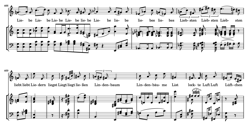
Or to intervene in the Other as a procedure, as in the paradigmatic Martin Heidegger: Was ist Metaphysik? (2014) by the Spanish poet and artist Roberto Equisoain.
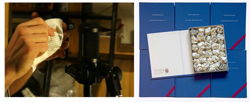
This is an ambivalent work, both as a sound action and as an art object. In the course of making it, the artist tears out the 30 pages of the eponymous Heidegger text one by one, and forms each one of them into a small ball (Fig. 5). The resulting sonority is insignificant (ripping out and crumpling the sheets) and the resulting object is, on its own, far from offering a transcendental experience (a box full of scrunched up papers), but by inhabiting the otherness of the Heidegger original, the completed work constitutes fascinating immaterial content that can “transform the very materiality of a discourse that is crying out for its own negation, to make it illegible and, in this way, to allow it to speak in a different manner” (Pérez Royo 2014). 2[2. Original in Spanish: “transformar la materialidad misma de un discurso que pide a gritos su propia negación, hacerlo ilegible y, de este modo, permitir que hable de otra manera.”]
Blanc
… In Its Incongruity
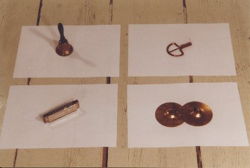
Other ideas, more than in the inhabited materiality of otherness, appear to us more as an incongruent materiality that transports us back to the realm of the immaterial. This incongruity typically arises through the use of the “wrong” medium to embody the sounding matter, as in the series Klänge auf Papier, which the Berlin-based, Austrian composer Peter Ablinger began in 1998. Here, a variety of objects that are recognizable sound-producing objects (conch shells, audio cassettes, kazoo) or that evoke sonorous activities (dinner plates and utensils, crinkled paper, hair dryer) are placed upon sheets of paper lying on the floor (Fig. 6). Ablinger convincingly underscores the incongruity of the collections of pairings by not naming the individual objects or instruments, but rather referring to them collectively simply as “sounds on paper”. The presentation format chosen for the series also elegantly and cleverly references the quintessential musical incongruity: the notated score, another form of “sounds on paper”.
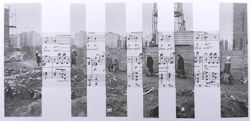
This sound-material dissonance is also at the core of the Liederbilder [Song-Images] series by Austrian cross-disciplinary artist Gerhard Rühm, created in 1992. The visuality of the images brutally disturbs the aurality of the score — or perhaps vice-versa. In one of the pieces, the score for a farewell song interlaces what would seem to be a small line of refugees walking past urban ruins (Fig. 7). The reality implied by the image is certainly too strong to be “represented” as music; or rather, music alone — as a medium — is incapable of embodying that which it seeks to articulate.
Très sincèrement silencieux
… In Its Impossibility
The Ablinger and Rühm works outline something that is unfeasible in their respective individual incongruities, but there indeed are other cases in which the impossible in fact proclaims itself as the main concept. These are ideas that are entirely unrealizable. Beautiful in themselves. Beautiful in their impossibility. Beautiful in their hopeless condemnation to the world of the immaterial, in their fate to never be able to exist as anything other than ideas.
TO PERFORM THIS PIECE
DO NOT PERFORM THIS
PIECE
Tony Conrad — Piece (1961)
In Gentle Fire (1971), American experimental composer Alvin Lucier instructs the reader to record specific “examples of ambient sound events” and to process and transform them “into what could be perceived as sound events of different origin.” Many of the source events seem to be anywhere from extremely difficult to impossible to realize: “Colliding meteors… Manouvering tanks… Spurting blood… Collapsing mines…” Not to mention the challenges involved for their transformation into: “Murmuring pines… Erasing errors… Healing cancers…”
And the pioneer in appreciating this poetics of the impossible was, of course, the French composer Erik Satie (1866–1925)…
Être visible un moment
… with performance instructions or even entire works that are quite unfeasible, notably the renowned Vexations (ca. 1893), which consists of a short fragment that is to be repeated 840 times, resulting in a total duration of around 18 hours. It is unsure if it was conceived by Satie as a work that was indeed meant to be played, or as a piece for the imagination, or as a joke, or perhaps all of the above at the same time, as no documentation of a performance of the work during the composer’s life is known to exist.
Plus loin
… In Its Possibility
The first known public performance of Vexations was only in 1963, and it is not by chance that the producer of this historical event was one John Cage, who would later give us the work ASLSP (As SLow aS Possible). Cage opted to leave as the sole tempo indication its title, which naturally invites extremely slow performances of the work that could easily last several hours. The work was conceived for piano in 1985 and adapted for organ in 1987 as Organ2/ASLSP (As SLow aS Possible). Several marathon performances of the work have been produced since its conception. 3[3. The author was personally involved in a very special performance of Organ2/ASLSP (As SLow aS Possible) in 2016 at the Conservatory of Music of Saragossa (Spain) with the collaboration of the performance class of Lluïsa Espigolé. The piece was performed without interruption over the course of 12 hours on a positive organ placed in the entrance hall, with performers relieving each other every 10–20 minutes.] One notable performance is still occurring (as of mid-2023). In 2001, in the cathedral of Halberstadt (Germany), the John-Cage-Orgel-Kunst-Projekt Halberstadt was initiated. An organ, custom-built for the event and electronically programmed to automatically perform Organ2/ASLSP over a period of time stretching over 639 years, began the performance — with a 17-month rest. 4[4. Consult the project website for a calendar of event changes, which are highly anticipated and usually attended by large audiences.]
When that which seems impossible is transfigured into something that is possible, even if we cannot properly experience it (due to, among other reasons, the immense time or space it occupies), the matter of possibility enhances the immaterial idea, providing it with that existential satisfaction of “knowing it is possible.”
With Estábamos. Venía [We Were There, It Came] (2015), the Spanish artists María Salgado and Fran Cabeza de Vaca set up an installation that was programmed to perform a two-month-long crescendo. Rising from the inaudible and growing constantly to an unbearable intensity, the crescendo was only interrupted by a live performance of 60 minutes that concluded the crescendo and thus the project. No one was present during those two months to experience the crescendo or even verify it was happening, nor was it even necessary. Just the idea of knowing that it was happening and later witnessing (live) the demolition of 87,840 minutes of growth is enough to experience its beauty, and it makes the performance substantially different than one formed from scratch, without the experience of these two unheard months. It is also a beautiful example of massive formal incongruity: an AB binary form, with the former lasting 87,840 minutes and the latter just 60 — a ratio of 1464:1.
Avec fascination
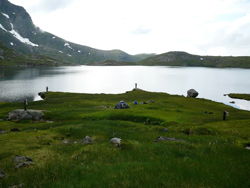
It is the poetics of the process, of the fascinating process of making possible that which is seemingly impossible, as it is explicitly shown in Norwegian composer Knut Olaf Sunde’s Molladalen (2007). Described as a “site-specific mountain concert for four trombones and walking audience in acoustic valley”, this 41-minute-long work is conceived to be performed in a remote region of Norway (Fig. 8), with access to the first performance position requiring a hike that is expected to take “a little more than 2 hours”. The question arises: Is the work just “the work”? Or is it rather the means to achieve it, the (deliberate) effort to place ourselves into a very special position where something that can only be very special is about to happen?
Finir pour soi
… And Walk
To walk as a way in and of itself. Or rather as a path. A (beautiful?) path through the immaterial and the material. Through that which is not there. Through that which we imagine. Through that of which we cannot speak. Through that which remains. Through all that is incompatible. Through everything that cannot be. Through that which is.
And to affirm the sounding beauty of ideas.
RIDEAU
Origins of the Erik Satie Indications
Avec étonnement: Trois Gnossiennes (1890 [1893?]), Gnossiennes N° 2
Modestement: Pièces froides (1897), N° 1. Airs à faire fuir
Postulez en vous-même: Gnossiennes (1890), Gnossiennes N° 1
Portez cela plus loin: Gnossiennes (1890), Gnossiennes N° 3
Enfouissez le son: Gnossiennes (1890), Gnossiennes N° 3
Du bout de la pensée: Gnossiennes (1890), Gnossiennes N° 1
Seul, pendant un instant: Gnossiennes (1890), Gnossiennes N° 3
Ne parlez pas: Aperçus désagréables (1908, 1912)
Ignorer sa propre présence: Les fils des étoiles (1891)
Blanc: Pièces froides (1897), N° 2. Danse de travers
Très sincèrement silencieux: Prélude de la porte héroïque du ciel (1894)
Être visible un moment: Pièces froides (1897), N° 2. Danse de travers
Plus loin: Pièces froides (1897), N° 1. Airs à faire fuir
Avec fascination: Pièces froides (1897), N° 1. Airs à faire fuir
Finir pour soi: Les fils des étoiles (1891)
RIDEAU: Prélude de la porte héroïque du ciel (1894)
Bibliography
Flynt, Harry. “Concept Art.” An Anthology. Edited by La Monte Young. First edition. New York, 1963. Available on the website of the author at http://www.henryflynt.org/aesthetics/conart.html [Accessed 25 May 2023]
Lehmann, Harry. Gehaltsästhetik: Eine Kunstphilosophie. Paderborn: Wilhelm Fink Verlag, 2016.
Lely, John and James Saunders (Eds.). Word Events: Perspectives on verbal notation. London: Continuum, 2012.
Pérez Royo, Victoria. “Martin Heidegger: Was ist Metaphysik? (Book Box).” Official website of Roberto Equisoain. Posted 28 September 2014. Available at http://robertoequisoain.com/2014/09/28/martin-heidegger-was-ist-metaphysik-book-box [Accessed 25 May 2023]
Social top